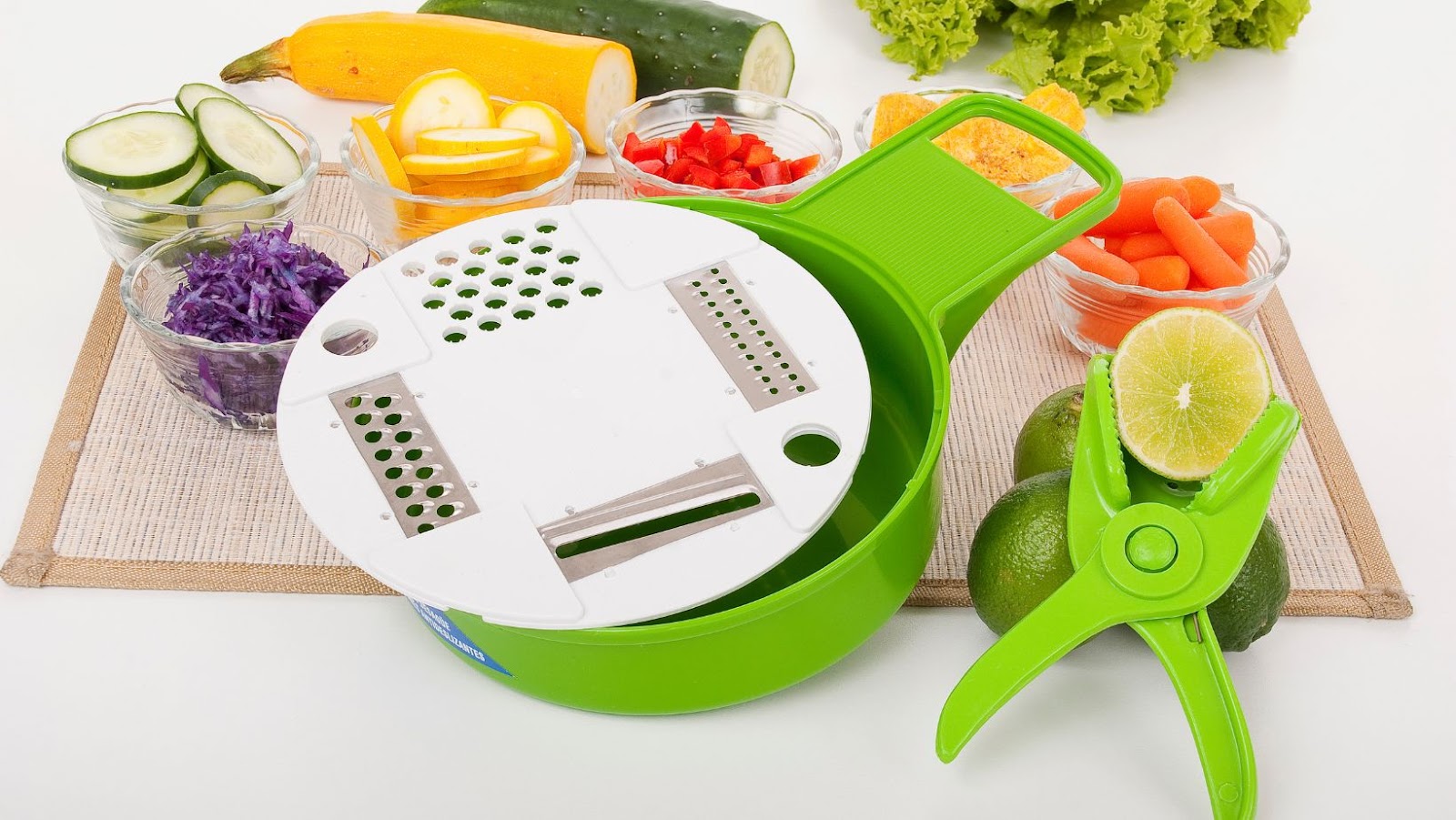
How To Choose The Right Food Processor For Your Kitchen
Food processors are versatile kitchen appliances that can complete many tasks with just a few button presses. From chopping vegetables to pureeing fruit, they make meal prep much faster and easier.
Understanding Task Capabilities of Food Processors
| Task | Capability |
| Chopping | Quickly chops vegetables and nuts |
| Pureeing | Makes smooth sauces, dips, and soups |
| Shredding | Shreds cheese and meat |
| Slicing | Cuts fruits and veggies into slices |
| Kneading dough | Makes bread dough quickly |
Food processors can also handle many other tasks such as emulsifying salad dressing or making whipped cream. They come in different sizes, styles, and power levels to suit various needs.
The history of the food processor dates back to the late 1960s when Carl Sontheimer developed a prototype that would process food much easier than traditional methods. Since then, they have become a staple in most households due to their convenience and speed of use. Choosing the right food processor is like finding a partner – it needs to be reliable, versatile, and able to handle whatever you throw at it.
Factors to Consider When Choosing a Food Processor
To choose the right food processor for your kitchen, you need to consider various factors that will help you find the perfect one for your needs. With the capacity and size, power and speed, blades and attachments, ease of use and cleaning, you can find the best food processor that will make meal prep a breeze.
What Can a Food Processor do
When choosing a food processor, one must consider the factors of its volume and physical dimensions. These attributes can impact how versatile the device can be in the kitchen. Here are some specific details to pay attention to:
| Factor | Description |
| Bowl Capacity | The amount of food that can fit inside the processing bowl at one time. |
| Feed Chute Size | The diameter measurement of the opening that allows ingredients to be fed into the processor. |
| Dishwasher Ability | Whether or not the entire device is dishwasher safe for easy cleaning. |
It’s worth noting that larger capacities and sizes don’t always mean better performance. One should assess their own needs and cooking habits before deciding which size works best for them. An important aspect not covered by table details is assessing how much counter space one has in their kitchen. Having enough room for a large processor may not be feasible in small kitchens.
I once had a friend who purchased an industrial-size food processor for their home use, thinking bigger was better. However, they found it was too cumbersome and took up too much space in their tiny apartment kitchen. They ended up gifting it to a restaurant owner who appreciated its large capacity and had plenty of counter space to accommodate it.
Who needs a Ferrari when you have a food processor with the power and speed to blend anything in seconds?
Power and Speed
When selecting a food processor, it is crucial to consider its level of force and acceleration. These factors determine the efficiency of the machine when processing food items. You would want a processor with high-speed settings that can handle tough foods like nuts, meat and hard vegetables.
Aside from the ability to process difficult foods, the speed and power should also depend on your intended use for the appliance. For instance, if you plan on using the processor frequently, then one with higher speed settings would be appropriate. However, for occasional use, a slower speed setting may suffice.
Another consideration when choosing power and speed is noise level. Machines with high wattage tend to produce more noise than those with lower wattage. So if you prefer a quieter machine, go for one that has less wattage.
As well as these factors, it’s important to check manufacturer specifications for each model being considered before making a purchase. This information can be accessed by researching through product analysis online or speaking with customer support representatives at the store where you plan to make your purchase.
A friend once shared their experience in acquiring a low-end food processor with insufficient power and sluggish speeds; they ended up having bits of unchopped vegetables in their meal as a result. It’s important not to compromise on power and speed when selecting a food processor as this directly impacts its performance.
Choosing a food processor with the right blades and attachments is key, unless you enjoy a chunky smoothie or a salsa that’s more like a salad.
Blades and Attachments
When selecting a food processor, evaluating its blades and attachments is crucial. An array of unique options cater to specific culinary needs, simplifying cooking tasks.
Consider a table with columns like Blade Type, Dimensions, Material, and Special Features while inspecting the attachments. Some blades such as S-blades chop veggies and nuts smoothly, whereas grating blades transform cheese into fluffy shreds.
Grinding plates work best for slicing steadily through meat and poultry. Also, you should check the dimension of the blade as per your requirements for creating larger or smaller chunks. Additional special features worth examining include dough hooks for bread-making enthusiasts or whisking disks ideal for making mayonnaise or whipping cream.
Don’t regret overlooking any attachments once you start preparing various recipes with this machine in your kitchen.
Choose what suits you best and avoid the FOMO!
Choosing a food processor based solely on its complexity is like picking a significant other based solely on their ability to solve a Rubik’s cube.
Ease of Use and Cleaning
When selecting a food processor, several aspects should be considered, including convenience of operation and cleaning. Here are some essential factors you should keep in mind to ensure that you make the right choice.
- Accessibility: Determine if it is convenient to use and clean. Check if the appliance has easy-to-read buttons, and whether its working parts can be removed for washing.
- Size and Capacity: The size of your food processor is also an important consideration, as you have to choose one with an appropriate capacity for your specific needs.
- Material Quality: Another factor when considering ease of use and cleaning is the material quality of the parts because some plastics crack after many uses. Stainless steel models last longer but are more expensive.
- Dishwasher Compatibility: Lastly, checking if the food processor is dishwasher compatible makes it even easier to clean, as long as all parts are made of dishwasher safe materials.
It’s crucial to pay attention to every aspect of your intended purchase so that you can get the most out of it without much stress. Avoid missing out on these vital considerations by taking note of them when purchasing a food processor today!
Looking for a new kitchen gadget? Here are the types of food processors to consider – because sometimes you need more than just a good knife and some elbow grease.
Types of Food Processors
To choose the right food processor for your kitchen, it’s important to understand the different types available to you. In order to make an informed decision, you’ll need to evaluate the needs of your household and your cooking habits. In this section, we introduce you to the three main types of food processors: mini, compact, and full-sized.
Mini Food Processors
A small-scale kitchen appliance that assists in food preparation and processing is known as a compact meal processor. These types of appliances have diverse designs, styles, and functionalities that allow for versatile food processing.
Mini food processors make it easier to chop, dice, shred or puree smaller amounts of ingredients for recipes such as pesto, hummus and baby food. They are easy to clean after use and take up less counter space compared to larger counterparts. Moreover, they are ideal for individuals who have limited kitchen space or budget constraints. It is important to note that while mini processors are efficient in handling small quantities of ingredients at a time, they may not be suitable for larger tasks like kneading dough or emulsifying liquids.
In addition, mini food processors also come with various attachments like blades, discs and cups designed specifically for particular culinary tasks. Apart from the basic chopping blade provided in most models, there are also models available equipped with shredding discs or blender cups suitable for making smoothies and sauces. Furthermore, these machines can handle a wide range of ingredients including vegetables, fruits and nuts with ease to help simplify meal prep.
I heard one interesting story about a woman who invested in a mini food processor to help her make her own fresh salsa every week without having to spend time chopping all the ingredients by hand. She was extremely happy with the efficiency of the machine and was able to save hours preparing meals throughout the week. Who needs a gym membership when you can get a workout just trying to fit everything into a compact food processor?
Compact Food Processors
When it comes to small and efficient kitchen helpers, there are some varieties of them, such as the ‘Compact food processors’. They come in handy when all you need is a quick blend or chop, or if your storage space is limited. In this section, we will explore the different types of compact food processors.
In terms of features, compact food processors come with options such as power wattage, capacity, and control settings. The table below illustrates a comparison between three popular brands:
| Brand | Power (Watts) | Capacity | Control Settings |
| A | 600 | 1.5 L | Adjustable |
| B | 700 | 2 L | Two-speed |
| C | 800 | 1.8 L | Three-speed |
Apart from the basic functionalities mentioned above, some compact food processors offer additional attachments for specialized tasks like kneading dough or slicing vegetables. These add-ons can be bought separately according to one’s needs.
On a related note, I remember my grandma using a compact food processor many years ago to make her famous salsa recipe for all our family gatherings. She would chop onions and tomatoes swiftly with the help of her beloved processor. It was always exciting to witness how quickly she could put together this delicious dish that we still enjoy today!
Need to process enough food to feed an army? Look no further than full-sized food processors – just don’t let them near your fingers.

Full-Sized Food Processors
When it comes to food processors, there are various types available in the market today. For those looking for a larger capacity appliance to cater for frequent heavy use, full-sized food processors come in handy. These devices have powerful motors and bigger bowls that can process large quantities of ingredients at once.
A table below showcases some of the features of a full-sized food processor:
| Features | Description |
| Bowl capacity | Usually ranges from 9-16 cups |
| Motor power | Usually around 600-1200 watts |
| Size | Tends to be bulkier with a height of around 16 inches |
| Attachments | A variety of attachments including slicing discs, shredding discs, dough blades and chopping blades |
One unique characteristic of full-sized food processors is their versatility in terms of the range of tasks one can perform with them. Besides common activities such as pureeing baby foods or chopping vegetables, one can also knead dough or even grind nuts using this type of processor.
If you love cooking and experimenting with different recipes that require processing larger quantities of ingredients, then investing in a full-sized food processor would be an excellent idea. With this appliance, you can take your culinary skills up a notch and prepare healthier home-cooked meals faster.
Don’t miss out on these fantastic benefits! Upgrade to a full-sized food processor today and enjoy whipping up new recipes effortlessly. Choosing a food processor is like choosing a partner, you want one that can handle all your needs without complaining about the workload.
Choosing the Right Food Processor for Your Needs
To choose the perfect food processor that fulfills your kitchen needs with specific tasks of processing different foods, think about your budget, what types of food you will be processing, and how frequently you will use it. In this section, we’ll briefly introduce you to the sub-sections: budget considerations, types of food you will be processing, and frequency of use, to help you make a well-informed decision.
Budget Considerations
When purchasing a food processor, there are several aspects to take into account. One of the critical factors that will dictate your choice is your “financial plan.”
- Consider how often you’ll use it: Before deciding on a budget, consider how frequently you’ll use the food processor. If you intend to use it regularly, choose a high-quality one without hesitating.
- Decide on features: Determine which characteristics are essential for your needs. If you’re on a tight budget but require basic components such as shredding or chopping vegetables, go with an affordable model.
- Look for Package Deals: Often manufacturers sell packages at discounts prices comprising food processors and other kitchen appliances. This could be an advantage if you need to upgrade different gadgets in your kitchen.
- Refurbished products- It’s highly recommended that if you’re on a low budget refurbish products is also another option for getting good quality at affordable pricing.
- Maintenance & Warranties- Ensure that suitable safeguards and warranties come with the product before purchasing it.
Finally, remember that money plays a part in selecting an acceptable food processor, but more importantly, purchase smartly to have no regrets regarding its use or longevity.
Pro Tip: Spending more upfront might save you money in the long term by avoiding countless repairs and replacements.
From smoothie bowls to nut butters, your food processor will be the MVP of your kitchen – unless you count yourself, of course.

Types of Food You Will be Processing
For any food processor, it is important to consider the types of ingredients and dishes that will be processed. This will ensure that the device you choose can handle the job at hand.
The following table lists the types of food that can be processed:
| Type of Food | Example Ingredients |
| Fruits | Apples, bananas, berries |
| Vegetables | Carrots, onions, broccoli |
| Meat | Chicken, beef, pork |
| Nuts | Almonds, walnuts, cashews |
When selecting a food processor for your needs, consider the specific types of foods you’ll be working with. For example, if you frequently prepare nut butter or grind meat, look for a model with a powerful motor and sharp blades designed for these tasks.
Pro Tip: Ensure that the food processor you choose has removable parts for easy cleaning and maintenance. You don’t need a fancy food processor if you only use it once a year for the obligatory Christmas fruitcake.
Frequency of Use
Acknowledging the amount of usage one has for a food processor is an essential factor in selecting the right appliance. The following sets of points delineate the importance of Frequency of Use:
- For regular use: it is advisable to select a model with high power and durability for longer lifespan.
- For occasional use: a basic and low-cost food processor may suffice for light tasks such as chopping, slicing or shredding.
- For professional use: it is imperative to opt for heavy-duty models with large capacities that can withstand frequent usage and deliver consistent results.
- For personal preference: if you value convenience and automatic settings, look for high-tech models equipped with advanced features such as self-cleaning mechanisms or touch screen controls.
Apart from Frequency of Use, other significant factors to consider are capacity, power, speed control settings, versatility in functionality, ease of cleaning and maintenance.
Pro Tip: Select a food processor that aligns not only with your frequency of use but also caters to your unique requirements.
Remember to give your food processor some love and attention, because neglecting it will only lead to a messy break-up.
Maintenance and Care for Your Food Processor
To ensure that your food processor stays functional for a long time, you need to maintain and take care of it properly. Cleaning and storage of the appliance is crucial for its longevity. Replacement parts and accessories will also come in handy in case of any malfunctions. Let’s dive into how you can implement these sub-sections to maintain and care for your food processor.
Cleaning and Storage
For the adequate functioning of your food processor, it is essential to maintain and take care of it regularly. Proper cleaning and storage are crucial for its longevity. Here’s how you can ensure that:
- Unplug the food processor and carefully disassemble it by removing all detachable parts.
- Clean each part thoroughly with warm water and mild soap. Use a soft-bristled brush to remove any stuck-on debris.
- Ensure that all parts are dried before storing them away in a cool, dry place.
- Finally, make sure to keep the blades and discs in separate containers to prevent damage.
It is important to check your food processor regularly for wear and tear or rusting parts if you don’t use it frequently or store it properly. Don’t let neglectful habits ruin your favorite appliance! Take care of your food processor like a professional so it will remain in top-notch condition for years to come.
People always say ‘you are what you eat’, but with replacement parts and accessories for your food processor, it’s more like ‘your food processor is what it eats’.
Replacement Parts and Accessories
The food processor may require replacement components or additional accessories to operate efficiently. These are crucial for the optimal functioning of the product.
- Blades, disks and bowls – Blades are an essential component of a food processor. They might quickly become blunt or damaged with frequent use, necessitating replacements or sharpening. Similarly, discs are used to grate or slice food into various sizes and shapes. Bowls that accumulate scratches occasionally need to be replaced to avoid contaminating your food with scratched plastic.
- Paddles and pushers – Paddles accommodate their specific model’s bowls and assist in processing items like thick doughs. Pushers fit into the feed tube on some models’ lids and help guide food through while keeping fingers safe.
- Attachments – Additional attachments for pureeing, grinding, shredding or making dough can also give you greater flexibility in the kitchen.
It is important to understand which replacement parts work best with your particular model by going through the user manual provided by the manufacturer. Not all parts are replaceable or compatible with every machine.
A well-maintained machine guarantees better results in cuisine readiness. Therefore, maintaining hygiene standards as per the instructions and guidelines will improve longevity.
In 1922, Pierre Verdun from France first established Robot Coupe: a company that produces commercial-grade processors that have been well-known since then. Recently Robot Coupe’s innovative technology has produced an array of options across its products in addition to being well-designed for compatibility purposes; they come equipped with stainless steel blades appropriate for more straightforward cutting precision without exception!
When it comes to food processors, finding the right fit is like finding a life partner- it should be efficient, reliable, and never leave you hanging mid-chop.






